Betty Boop's Grandfather
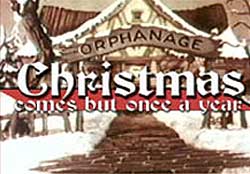 Betty Boop's grandfather became a regular character known as Grampy, a white-bearded old gent who was a great inventor. Betty came to play second-fiddle in some of her cartoons after the Production Code of 1934 made it increasingly difficult to make her sexy without getting censored. Grampy spiced up many episodes as he took over stories with his inventions.
Betty Boop's grandfather became a regular character known as Grampy, a white-bearded old gent who was a great inventor. Betty came to play second-fiddle in some of her cartoons after the Production Code of 1934 made it increasingly difficult to make her sexy without getting censored. Grampy spiced up many episodes as he took over stories with his inventions.
So too Pudgy, Betty's puppy, would become the focus of many of the later episodes. But once, Grampy & Pudgy entirely displaced Betty with a cartoon of their own, in full color at that, when Betty herself starred in black & white cartoons.
An orphanage on Christmas morning is the setting of Christmas Comes but Once a Year (19360>. Pudgy the pup slides down a schute into one of an orphan's arms, & all the kids leap out of bed singing "Christmas Comes But Once a Year."
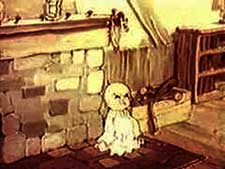 They hurry to fetch their stockings hung the night before. One kid has a pop-gun that falls apart. Another has a soccer ball that pops. Another has a tricycle that collapses into pieces. Another has a teddy bear who loses all his sawdust. They hurry to fetch their stockings hung the night before. One kid has a pop-gun that falls apart. Another has a soccer ball that pops. Another has a tricycle that collapses into pieces. Another has a teddy bear who loses all his sawdust.
All the children are crying their eyes out. Inventor Grampy with is easily mistaken for Santa due to his long white beard. He's driving by in his electric sled when he hears the orphans weeping their hearts out. Grampy puts on his magic thinking cap & comes up with a plan.
He climbs in the orphanage window & piles up broken toys, kitchen utensils, washroom equipment, & begins putting it together in various novel ways: a snow-sled made of washboard & wooden hangers; an airplane made with tube of cardboard & some spoons; a banjo from a frying pan. After considerable imaginative preparations he dresses up like Santa & calls in the kids anew. for a much happier outcome.
Technicolor, with some three-dimensional FX, ending with a promo for Christmas Seals, Grampy's Christmas Comes But Once a Year is lovely & sweet.
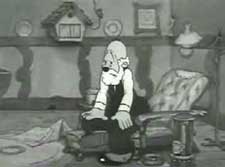 In Betty Boop & Grampy (1935), Betty has been invited to her Grampy's party. The invite says to bring the gang.
In Betty Boop & Grampy (1935), Betty has been invited to her Grampy's party. The invite says to bring the gang.
She sings "I'm On My Way To Grampy's House" as she strolls along the street gathering up the gang: construction workers, a fireman, a traffic cop...they all abandon their work in favor of going to Grampy's party.
As an inventor, Grampy's creations are displayed throughout his house, including a special cake slicer, a hand-shaking machine, a punch bowl that lowers from the ceiling. Betty asks for music, so Grampy puts on his thinking cap, the light comes on & he exclaims "I've got it!"
He turns his whistling tea-kettle into a picolo player, with gloves added to a whirling fan to finger the picolo. A clever drum kit is likewise made, & soon everyone's dancing with Betty, & Grampy's tapdancing.
The song is "Hold that Tiger" but Betty's not singing it; it's being sung by none other than Mills Brothers, who also did three Fleischer sing-alongs, their first having been I Ain't Got Nobody (1933). Everyone but Grampy dances themselves into weariness, but Grampy keeps going tirelessly.
More about cuteness than cleverness, it's just so-so for Betty. Her hemline is near her knees thanks to the Production Code & she's trying hard not to be too sexy. Her previously showing garter vanished & her sexy behavior was too much subdued. She would from 1935 to 1939 be co-starred more & more with new characters as she had lost too much of her individual cache.
The Fleischers could not afford to spend time making a hip cartoon only to have it censored, so they censored themselves, relying more & more on sundry guest-stars for Betty.
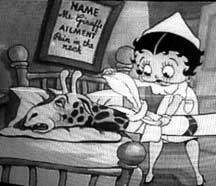 Betty runs an animal hospital in A Song a Day (1936). Billy Goat can't sleep because he swallowed an alarm clock. Mr. Woodpecker has a bent beak after mistaking an iron post for a tree. A. Herring's ailment is he got pickled & has a hangover. The funny ailments are piled on in the extensive hospital ward.
Betty runs an animal hospital in A Song a Day (1936). Billy Goat can't sleep because he swallowed an alarm clock. Mr. Woodpecker has a bent beak after mistaking an iron post for a tree. A. Herring's ailment is he got pickled & has a hangover. The funny ailments are piled on in the extensive hospital ward.
Betty in a nurse's outfit with conservative hemline sings, "Your life will be worth living if you do your share/ You'll feel the thrill of giving that's beyond compare" while wrapping the neck of a giraff with a soar throat.
It gets overwhelming for Betty when the varioius animals in agony begin wailing, crowing, screaming, & otherwise exhibiting discomfort or illness. She calls up Grampy for help. He puts on his thinkin' cap & when the light goes on exclaims, "Hooray! I've got it!" & puts his genius for novelty inventions to work for the sick & infirm beasties.
SInce music is a healing experience, Grampy builds an automatic band out of household objects & begins tapdancing & scat-singing as the animals become the humming choras, join the tapdancing, & otherwise forget their ills in the joy of song & dance. It ends with Betty & Grampy tapdancing together, a groovy moment.
As Grampy episodes go, this is a good one, because Betty remains the star & his is a support role. His tapdance scat jazz is better than her wussy song, but otherwise Betty shines as the animals' Florence Nightingale.
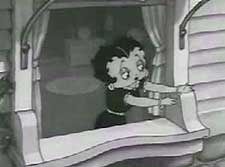 Be Human (1936) opens with Betty at the piano playing & singing the title song: "Be Human, animals can cry. Be Human, it's easy if you try." The song has some amusing lyrics but not jazzy or particularly good.
Be Human (1936) opens with Betty at the piano playing & singing the title song: "Be Human, animals can cry. Be Human, it's easy if you try." The song has some amusing lyrics but not jazzy or particularly good.
A vicious farmer next door isn't very human, being abusive to his dog, whipping it mercilessly (the abuse is protrayed quite horribly). "Stop that! Hey you stop that!" cries Betty from her window.
She sings her song to the abuser trying to reach his heart, but he just sets out to abuse the cow for not giving milk, & the hen for not laying properly. "You terrible person! I"ll fix you, you just watch!" threatens Betty, who calls Professor Grampy at the animal welfare office.
"Goody goody goody!" says Betty Betty Betty when Grampy picks up the animal abuser, drops him in a pit where he's punished by a whipping machine treadmill. The treadmill operates all sorts of devices that feed or entertain the farm animals, who in turn become very productive.
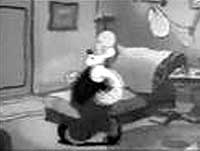 "Colossal Carnival Today Only. Also All Week!" says the sign on the side of the circus van, with a clown playhing a caliope on the tailgate. Betty & the little kid Junior are eager to go, & Betty sings the indifferent "We'll Have a Bushel of Fun" to get in the mood.
"Colossal Carnival Today Only. Also All Week!" says the sign on the side of the circus van, with a clown playhing a caliope on the tailgate. Betty & the little kid Junior are eager to go, & Betty sings the indifferent "We'll Have a Bushel of Fun" to get in the mood.
So begins Grampy's Indoor Outing (1936) with not only Grampy upstaging Betty, but also her mysterious ward (nephew or illigitimate son; no cartoon explains why she sometimes has a kid who seems to have no other parents).
When Betty & Junior are dressed & ready to go, a sudden storm destroys their plans, & Junior begins weeping, then throws a hideous tantrum. Professor Grampy hears the uproar & putting on his thinking cap thinks up how to entertain Junior indoors.
"Hooray! I've got it!" exclaims Grampy who sets out to build carnival rides out of stuff around the apartment. Following surprisingly few gags, the film ends. Judged for its music or its gags it just ain't much, but at least Betty interacts from beginning to end rather than being a background character as too often happens when Grampy or Junior are in the tale.
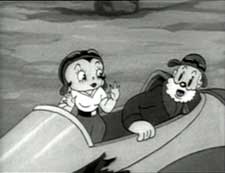 Grampy takes over the Betty Boop cartoon Zula Hula (1937). A storm knocks Grampy's airplane out of the sky. He & Betty have a forced landing on a tropical island, or perhaps it's a coastal lagoon of Africa.
Grampy takes over the Betty Boop cartoon Zula Hula (1937). A storm knocks Grampy's airplane out of the sky. He & Betty have a forced landing on a tropical island, or perhaps it's a coastal lagoon of Africa.
"Don't worry Betty! Everything will be hotsy totsy!" says Grampy, punning Hottentots. She hopes he's right, because she needs a shampoo. Grampy uses his inventor's genius to build a wonderful hut with all sorts of helpful amenities & modern devices made of jungle stuff.
The array of invention gags are pretty cool, but the islanders who interupt their idyl are are racistly drawn black people. "Oh Grampy! We'll be killed to death!" Grampy puts on his thinking cap but a native spear knocks it off. He tries it again & its slow to light up. But eventually he exclaims, "I've got it! I'll get these fellers!"
He transforms the plain engine into an automatic band that plays a jumping cartoon tune that gets all the natives hoola dancing with Grampy & Betty. While the natives are still dancing, Grampy makes a minimalist airplane with the propeller operated by a monkey after a banana, & they fly to freedom.
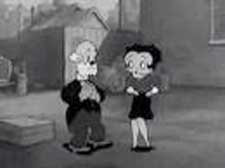 Grampy runs for the mayor's office in The Candid Candidate (1937). Betty Boop sings the campaign song "Vote for Grampy." She's again the toned-down Betty without garter showing & subdued sexuality thanks to the Production Code.
Grampy runs for the mayor's office in The Candid Candidate (1937). Betty Boop sings the campaign song "Vote for Grampy." She's again the toned-down Betty without garter showing & subdued sexuality thanks to the Production Code.
Grampy wins & Betty becomes his secretary. Suddenly Grampy is overwhelmed with citizens' complaints. The public threatens to impeach if he doesn't fix everything immediately.
Out comes the magic thinking cap. Straining & grunting, the light goes on atop the cap, & Grampy sets out to fix everything with his numerous instant inventions & rapid fixes. Soon Grampy is being hoorayed from all quarters.
The rest of the film shows how the city works after Grampy's novel changes have made everything just a little surreal. He even controls the rain.
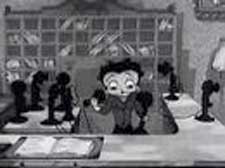 Also due to the production code, later Betty stories weren't even all that jazzy, despite her origins in flapper culture & ragtime jazz. Service with a Smile (1937) begins teasingly because its setting is the Hi De Ho hotel.
Also due to the production code, later Betty stories weren't even all that jazzy, despite her origins in flapper culture & ragtime jazz. Service with a Smile (1937) begins teasingly because its setting is the Hi De Ho hotel.
This can't help but remind a viewer of Betty's glory days when she danced with the Hi De Ho man himself, Cab Calloway. It can lead to the expectation of some jazz performers living in the hotel, but no such luck.
The hotel promises 40 Rooms, 2 Baths, & food service with every meal. Betty works the desk offering the titular Service with a Smile. Soon the complaints are coming & it's hard for Betty to keep smiling.
Not that they're wrong to complain. One guy can't get the drawers open in the chest of drawer. Another has a pillow stuffed with cement. In a bathtub one chap gets ice cubes out of the hotwater tap. The place is dirty, dinner isn't ready, there's a mouse in one room. Betty can't do it all alone & is soon weeping rather than smiling.
In comes the inventor Grampy who offers to help Betty. He puts on his thinking cap, the light goes on, & he starts with the wacky inventions that get all the problems taken care of.
It's Grampy's cartoon for the final third as he makes useful stuff out of other useful stuff to take care of the problems at hand. For example, hot water is gotten to a shower by hooking up a coffee percolator on the gaslights to boil over into a colonder.
Most of the gags are only so-so & not Grampy's best work, but who cares, Grampy is a one-joke guy from word go, & by now he's just basically beginning to suck.
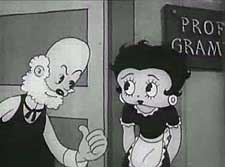 Grampy gets sole billing in some of the Betty Boop & Grampy cartoons, having become the bigger star after Betty's heyday was over. Sometimes Grampy totally dominates in terms of screen minutes. But in The Impractical Joker (1937) he doesn't show up until nearly halfway through the tale, & Betty is center stage despite that her name was dropped from the opening title credit.
Grampy gets sole billing in some of the Betty Boop & Grampy cartoons, having become the bigger star after Betty's heyday was over. Sometimes Grampy totally dominates in terms of screen minutes. But in The Impractical Joker (1937) he doesn't show up until nearly halfway through the tale, & Betty is center stage despite that her name was dropped from the opening title credit.
Betty's a kitchen maid courted by a bucktooth jerk named Irving who thinks the best way to woo a lady is to play practical jokes on her. He shakes hands with a removable hand. He gives her a box of candy with a pop-up devil that scares the bejabbers out of her, then scares her worse with a phony snake.
Growing angrier & angrier, Betty goes upstairs to Professor Grampy's room & solicites his inventor's prowess in her behalf. After putting on his Thinking Cap, Grampy comes up with sundry inventions that should do the trick.
Betty has Irving take a cake upstairs to Grampy. Irving replaces the candle with a firecracker while still on the staircase heading for Grampy's room.
Grampy's inventions pretty much do Irving in. Except Irving gets the last laugh because the old guy failed to detect the firecracker, & when he & Betty sit down to share the cake, Grampy makes the mistake of lighting the "candle."
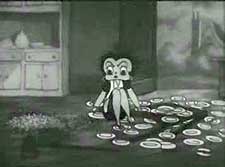 House Cleaning Blues (1937) again drops Betty Boop from the opening title card credit, giving Grampy sole billing even though Betty's got more screen time in this one.
House Cleaning Blues (1937) again drops Betty Boop from the opening title card credit, giving Grampy sole billing even though Betty's got more screen time in this one.
How shortsighted that the Fleischers lost faith in Betty as a leading lady. They first of all reduce her from vaudeville & burlesque star to babysitter or housemaid or cook or nurse, then write scripts more for her co-stars than her. No wonder they gave up on her altogether in 1939 & concentrated on Popeye cartoons.
In earlier cartoons Betty lives humbly in a small rural cottage or in an apartment in an inner city working class neighborhood. Here, though, she seems to own a mansion along a gorgeous tree-lined lane, & lives in the big old place all alone.
Betty's caged canary wakes her up at dawn. In an absolutely stunning camera pan we get a three-dimensional view of the messy rooms. From the banner hanging askew we know there was a birthday party the night before, & revelers have left a mess everywhere.
Noting the enormity of each room there must've been at least fifty guests to mess up so much space. And note the arched ceiling of Betty's bedroom, the grand piano in the expansive music room. Maybe she won the lottery.
Singing "House Cleaning Blues" she begins cleaning up cigarette butts, roles up filthy carpets, sweeps floors, but then accidentally spills the garbage she just gathered & stumbles into the piled-high dirty dishes.
Losing her temper she begins breaking more dishes & pulling long faces & stomps on a broom handle so hard the broom pops up & nearly knocks her unconscious.
Grampy is in his gussy automobile, coming over to get Betty to join him for a drive. She can't go because the house is too messy & she has to clean it up. So Grampy puts on his thinkin' cap, the light comes on, & he tapdances a gay "Hooray! I've got it!"
The rest of the film is an array of cleaning devices he quickly invented, none of which make any real sense but are cute. Then off he goes with Betty in his fancy car which has a private soda fountain in it.
copyright © by Paghat the Ratgirl
|
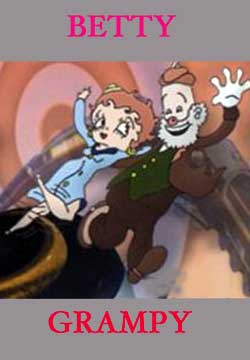

 They hurry to fetch their stockings hung the night before. One kid has a pop-gun that falls apart. Another has a soccer ball that pops. Another has a tricycle that collapses into pieces. Another has a teddy bear who loses all his sawdust.
They hurry to fetch their stockings hung the night before. One kid has a pop-gun that falls apart. Another has a soccer ball that pops. Another has a tricycle that collapses into pieces. Another has a teddy bear who loses all his sawdust.







